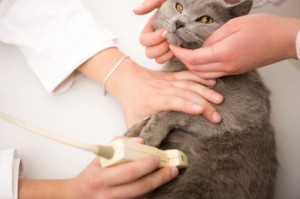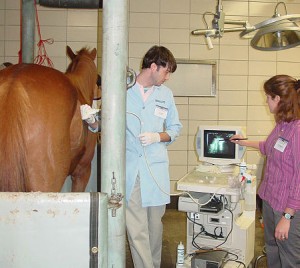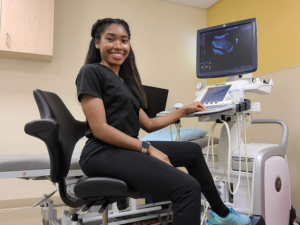How Ultrasound is Improving the Lives of Animals
Sonography is increasingly becoming important in healthcare. But it is not only used on human patients. More and more veterinary settings are performing ultrasounds on their feline, canine and other animal patients as well.
An article from the Society of Diagnostic Medical Sonography’s magazine News Wave (“Increasing Demand for Veterinary Sonography Creating Opportunities for Sonographers” by Beth W. Orenstein) opens with how Fern Ann Delaney, RDMS, performs significantly more ultrasounds on animals compared to 13 or so years ago.
When Delaney first began as a sonographer at the University of Wisconsin in Madison’s Veterinary Medical Teaching Hospital, she was only really busy once a week with around five cases that particular day. “These days, she does between eight and 10 cases a day – everyday – and on a variety of animals from cats and dogs to ferrets and snakes,” wrote Orenstein in the 2011 article.

Orenstein’s article also described the mobile sonography service performed by a Eugene, Oregon-based sonographer, Tomie Timon, RDMS, RVT. Timon travels to various vet clinics and hospitals to perform abdominal ultrasounds and echocardiograms on five or six patients (like birds, dogs, snakes and guinea pigs) a day.
Furthermore, therapeutic ultrasound is growing in importance to benefit animals. For example, Jennifer Brooks in her Equine Wellness Magazine article “Making Waves” (2010) describes how she performs therapeutic ultrasound on horses. (Brooks first became a human physical therapist and then further specialized to become an equine rehab therapist).
Ultrasound’s Growing Use In Animal Healthcare
Since ultrasound is non-invasive and non-radiographic, is increasingly becoming more portable and is cheaper than other imaging technologies, (like CT and MRI technologies), sonography is becoming ever more popular a tool in animal healthcare. And it is not just sonographers or ultrasound technicians that perform the imaging tests on pets. More and more, veterinarians are also performing sonography.
Pursuing Your Training
 What are the requirements for veterinary ultrasound technicians? Veterinary professionals can take continuing education courses through numerous colleges, universities and associations to gain essential skills in ultrasound.
What are the requirements for veterinary ultrasound technicians? Veterinary professionals can take continuing education courses through numerous colleges, universities and associations to gain essential skills in ultrasound.
If you are considering pursuing a career as a veterinary tech, you’ll notice that numerous degree programs include at least one course in diagnostic imaging ultrasound.
The Veterinary Support Personnel Network (VSPN) encourages veterinary technicians to become trained in sonography as well.
“Veterinary technicians can increase their worth to a practice by learning these techniques,” stated the VSPN. “Acquiring the ultrasound image requires training, but you do not need to be a veterinarian to be a good ultrasonographer”.
The International Veterinary Ultrasound Society (IVUSS) promotes research and provides education in diagnostic ultrasound in veterinary medicine. You can learn more about the veterinary ultrasound certification program, including a program overview and prerequisites on their website.
Whether you are a pet owner, an aspiring sonographer, or a longtime vet, find out how ultrasound is already employed in your community. Discover how it can benefit you personally, professionally and most importantly, the animals you love.

Candice Sellers, B.S., RDMS – Contributor Students attending ultrasound school consistently report that ultrasound physics is one of the most difficult courses in their program. It’s a required course and one that is important to master. Below you will find study tips and tools available to students to help them focus and hone in on…
How I Mastered Ultrasound Physics

By Adrienne Hardy, RDMS (Ab, Ob/Gyn) – Contributor According to the SDMS, 90% of sonographers will sustain a work related musculoskeletal disorder; 20% will have a career ended because of the injury. With numbers this high it seems like it’s an inescapable truth that you must scan in pain or get injured at some point…
Most Common Injuries in Sonographers

By Adrienne Hardy, RDMS (Ab, Ob/Gyn) – Contributor As I sat in my entrance interview for sonography school the professors spattered me with questions: “Do you have enough savings? What is your home like? How do you manage your time? Do you have someone who cares about your success and will support you in hard…
Surviving and Thriving in Sonography School

We recently had the pleasure of speaking with Carlos Reveles, a high risk Ob/Gyn sonographer. In this interview, Carlos shares with us what led to him being recently recognized as a standout sonographer by his employer, and what it’s like being a male in a traditionally female field. Welcome Carlos! Hello my Name is Carlos…
Explore Carlos’s Sonography Journey

Adrienne Hardy, RDMS (Ab, Ob/Gyn) – Contributor I clicked submit on the SPI physics exam and ran out the the room. The test proctor handed me a piece of paper with a huge scared looking picture of myself taken before the exam, my ARDMS number and the results of my SPI examination. My hand shook as…
Passing the Sonography Principles and Instrumentation Exam

Candice Sellers, B.S., RDMS – Contributor The Ultrasound School Experience Ultrasound school is a very exciting and rewarding experience. The excitement of finally reaching your goal of getting accepted into an accredited ultrasound program is certainly a tremendous milestone! However, there will be moments of frustration and stress that will occur during your journey in…
How I Managed Stress While in My Sonography Program

DruAusten Fields, RDMS (AB, OB/GYN), RVT – Contributor The Skilled Sonographer, DruAusten Fields, RDMS (AB, OB/GYN), RVT looks back on the development of her SPI test prep mini-course, and her work to help others pass their SPI exam. When I look back on where I started versus where I am, I can confidently say I have…
Tap into Dru’s Diagnostic Imaging Expertise

Adrienne Hardy, RDMS (Ab, Ob/Gyn) – Contributor What to expect as you transition from DMS student to the medical imaging workplace. Congratulations! You ran the marathon of Sonography school and now have gotten a job! What a relief, right? All the pent up anxiety and pressure of ultrasound school feels let off like a pressure valve…
Surviving the Transition: From Student to Sonographer Pro!

Lynn Nguyen – Sonography Student & Contributor Join Lynn on her journey as she pursues a 2nd career as a sonographer. Why Sonography? How Did I Get Here? I have never given sonography a thought much less loving the thought that I am going to be a sonographer one day. In high school I knew…
Why I Chose Diagnostic Medical Sonography

DruAusten Fields, RDMS (AB, OB/GYN), RVT – Contributor The Skilled Sonographer, DruAusten Fields, RDMS (AB, OB/GYN), RVT shares her sonography story! From Indecision to Decision Deciding on a lifelong career can be stressful, especially at a young age. During high school was when I began toying with the idea of pursuing a career in the…
Systems for Success in Sonography

Sam Callis, contributor at USI, is an author and sonographer with experience in multi-specialty clinical practice, higher education, and the medical device industry. She is the author of Diagnostic Medical Sonography – The Definitive Guide to Planning Your Career. We were first introduced to Samantha back in 2019 with this terrific interview in which she…
From Art to Science: A Sonographer’s Unique Career Path
The demand for healthcare professionals, including those specializing in medical imaging, continues to rise. As the aging baby boomer population grows, there is an increasing need for diagnostic imaging procedures, alongside a demand for new providers to fill positions vacated by retiring workers. This ongoing expansion in medical imaging careers presents excellent opportunities for individuals…
Updated for 2025

 What are the requirements for veterinary ultrasound technicians? Veterinary professionals can take continuing education courses through numerous colleges, universities and associations to gain essential skills in ultrasound.
What are the requirements for veterinary ultrasound technicians? Veterinary professionals can take continuing education courses through numerous colleges, universities and associations to gain essential skills in ultrasound.











